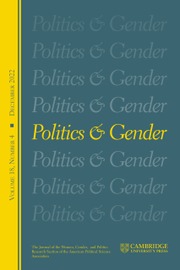Article contents
A Comparative Approach to Explaining Gender Disparities in Asian American and Asian Canadian Politics
Published online by Cambridge University Press: 30 September 2024
Extract
In 2020, Asian Americans were the least descriptively represented at all levels of elected office compared to whites, Blacks, and Latinos (Sedique, Bhojwani, and Lee 2020). In this context, Asian women lagged behind Asian men in holding local-level positions, yet they surpassed Asian men in holding federal and statewide offices, and they led 81% of state- and local-level Asian civil rights organizations (AAPI Power Fund 2020; Reflective Democracy Campaign 2021). Do gender disparities in Asian American political representation arise because Asian women are less likely to run for office than Asian men, or because they are less likely to win elections? Do these disparities vary across levels of office? And are they unique to Asian Americans?
- Type
- Critical Perspectives Article
- Information
- Copyright
- © The Author(s), 2024. Published by Cambridge University Press on behalf of the Women, Gender, and Politics Research Section of the American Political Science Association
References
- 1
- Cited by


